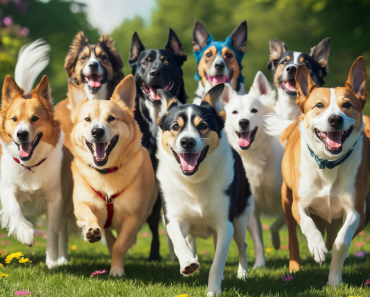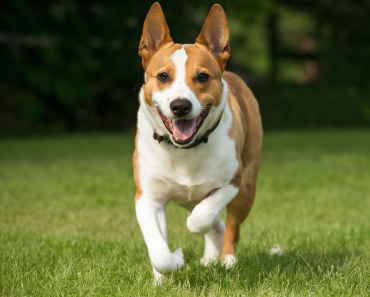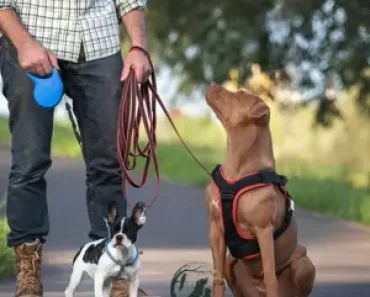Dogs are incredible creatures, often considered man’s best friend. But as any dog owner knows, understanding what our furry friends are trying to communicate can sometimes be a bit challenging. Dog behavior is a fascinating subject, and by learning to read your dog’s body language, you can foster a stronger bond and ensure your pet’s happiness and well-being. This comprehensive guide delves into the intricacies of dog behavior, focusing on what your dog’s body language is telling you.
Dogs communicate primarily through body language. While they do bark, whine, and growl, their most nuanced messages are conveyed through physical cues. Recognizing these signals is crucial for:
- Building a Stronger Bond: Understanding your dog’s needs and feelings.
- Preventing Misunderstandings: Avoiding situations that might cause stress or aggression.
- Ensuring Safety: Protecting your dog and others around it.
The Basics of Dog Behavior : Dog’s Body Language
1. Ears
- Perked Up: Alert and interested.
- Flat Against Head: Fearful or submissive.
- Relaxed: Content and calm.

Dog Behavior Dog Behavior Dog Behavior Dog Behavior
2. Eyes
- Wide Open: Alert or anxious.
- Squinting: Relaxed and happy.
- Avoiding Eye Contact: Submissive or unsure.
3. Mouth
- Panting: Hot, stressed, or excited.
- Yawning: Tired or stressed.
- Licking Lips: Anxious or submissive.
4. Tail
- Wagging: Excited or happy (but context matters).
- Tucked Between Legs: Fearful or submissive.
- Held High: Confident or aggressive.
Detailed Analysis of Dog Behavior
Understanding dog behavior requires attention to combinations of signals, not just isolated cues. Let’s dive deeper.
1. Relaxed and Happy Dog
When a dog is relaxed and happy, its body language is loose and flowing. Look for these signs:
- Tail: Wagging gently, held at mid-level.
- Ears: Relaxed and in a natural position.
- Mouth: Slightly open, possibly with the tongue hanging out.
- Eyes: Soft, sometimes squinting.
These dogs are approachable and friendly. They are in a state of contentment and are open to interaction.
2. Playful Dog Behavior
Playful behavior is often characterized by exaggerated movements. A playful dog may exhibit:
- Play Bow: Front legs stretched out, rear end in the air.
- Bounding Movements: Jumping or pouncing around.
- Tail: Wagging energetically.
- Ears: Perked up and alert.
Playful dogs are looking for fun and interaction. This behavior is common in puppies but can be seen in dogs of all ages.
3. Alert Dog
An alert dog is focused on something specific. This could be a noise, a sight, or a smell. Indicators include:
- Ears: Pointed forward or moving to catch sounds.
- Eyes: Wide open, sometimes with dilated pupils.
- Body: Stiff and leaning slightly forward.
- Tail: Held straight out or slightly raised.
Alert dogs are not necessarily aggressive; they are simply paying close attention to something in their environment.
4. Anxious or Fearful Dog
Recognizing anxiety or fear in dogs is crucial for preventing stress-related behaviors. Signs include:
- Ears: Pinned back against the head.
- Tail: Tucked between the legs or low and still.
- Body: Crouched or trying to make itself look smaller.
- Mouth: Closed, with lips drawn back slightly.
An anxious dog may also whine, bark, or try to hide. It’s important to comfort your dog and remove the source of fear if possible.
5. Aggressive Dog
Aggression in dogs can be a serious issue and understanding the warning signs is essential. Look for:
- Ears: Pinned back tightly against the head.
- Eyes: Narrowed or glaring.
- Mouth: Lips curled, showing teeth, possibly growling.
- Body: Stiff and tense, possibly leaning forward.
- Tail: Held high and stiff, sometimes bristling.
An aggressive dog may also lunge or snap. It’s vital to approach such dogs with caution and seek professional help if aggression is a recurring issue.
How to Respond to Your Dog’s Body Language
Now that you know what different body language cues mean, here’s how you can respond appropriately:
1. Responding to a Relaxed and Happy Dog
- Reward with Attention: Petting, treats, or verbal praise.
- Engage in Play: This reinforces their positive state.
- Maintain a Calm Environment: To keep them content.
2. Responding to a Playful Dog
- Join the Fun: Engage in play to satisfy their energy.
- Provide Toys: Safe and engaging toys to keep them entertained.
- Encourage Socialization: Play dates with other dogs.
3. Responding to an Alert Dog
- Check the Environment: See what has caught their attention.
- Stay Calm: Your calmness can reassure them.
- Redirect Attention: Use toys or commands to shift their focus.
4. Responding to an Anxious or Fearful Dog
- Provide Comfort: Soft words, gentle petting, and a safe space.
- Avoid the Trigger: Remove or distance them from the source of fear.
- Professional Help: If anxiety is severe, consult a vet or behaviorist.
5. Responding to an Aggressive Dog

Dog Behavior Dog Behavior Dog Behavior Dog Behavior
- Stay Calm and Avoid Eye Contact: Direct eye contact can be seen as a challenge.
- Do Not Approach: Keep your distance to avoid provoking an attack.
- Seek Professional Help: Aggression often requires training and professional intervention.
The Role of Training in Understanding Dog Behavior
Training is crucial in shaping your dog’s behavior and helping you understand their body language. Here are some key training tips:
1. Basic Commands
Teaching basic commands like sit, stay, come, and leave it can help you manage your dog’s behavior more effectively.
2. Socialization
Exposing your dog to different environments, people, and other animals helps them become well-adjusted and less anxious.
3. Consistency
Being consistent with commands and rewards helps your dog understand what is expected of them.
Common Misconceptions About Dog Behavior
There are many myths about dog behavior that can lead to misunderstandings. Let’s debunk a few:
1. Wagging Tail Means Happy Dog
While a wagging tail often indicates happiness, it can also mean excitement, anxiety, or aggression. Context is key.
2. Dogs Feel Guilty
That “guilty look” is often a reaction to your body language rather than an understanding of their wrongdoing.
3. Aggression is Dominance
Not all aggression is about dominance; it can be fear-based or due to lack of socialization.
The Significance of Customary Vet Visits
Regular check-ups with a veterinarian are basic. Wellbeing issues can regularly show as changes in behavior.
By keeping up with vet visits, you can guarantee your dog’s wellbeing and address any behavioral concerns early.
Tools and Assets for Understanding Puppy Behavior
1. Books
• “The Other Conclusion of the Chain” by Patricia McConnell
• “How to Talk Canine” by Stanley Coren
2. Online Courses
• Courses from the American Pet hotel Club (AKC)
• Udemy and Coursera have different pet behavior courses.
3. Proficient Help
• Certified canine trainers
• Animal behaviorists
Conclusion

Dog Behavior Dog Behavior Dog Behavior Dog Behavior
Understanding dog behavior is a journey that requires patience, observation, and a willingness to learn. By paying close attention to your dog’s body language, you can better meet their needs and foster a strong, trusting relationship. Remember, each dog is unique, and getting to know your dog’s specific signals will take time. But the effort is well worth it for the love and companionship your dog provides.
In summary, knowing what your dog’s body language is telling you is fundamental to ensuring their happiness and safety. It’s about more than just avoiding miscommunication—it’s about building a life of mutual understanding and respect. So take the time to observe, learn, and respond to your dog’s cues, and you’ll both reap the rewards of a deep, loving bond.






